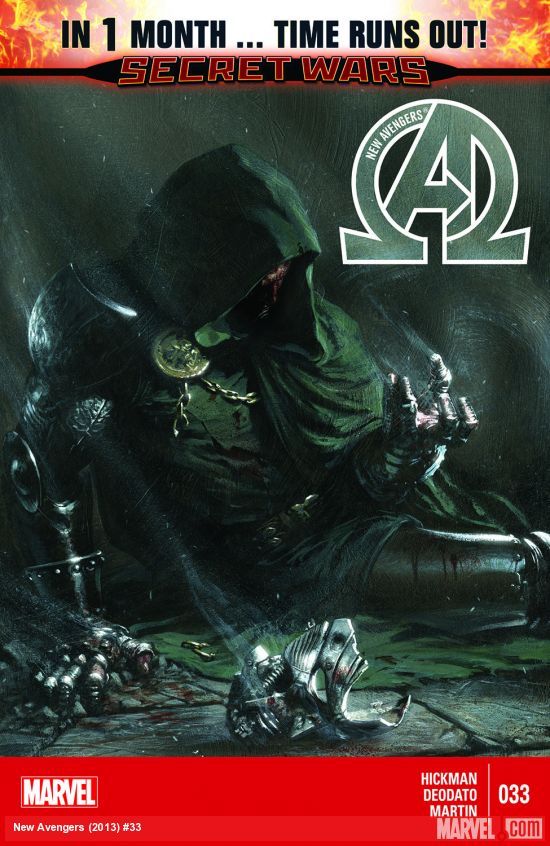"New Avengers" #33 springboards into "Secret Wars" with a number of answers -- but not necessarily clarity. Jonathan Hickman and Mike Deodato reveal what's been happening behind-the-scenes in the sprawling saga of Rabum Alal, Beyonders and Incursions and, while it's rewarding to understand the bigger picture, the execution can be plodding. A too indulgent script and some uneven art from Deodato bog down the big reveals, though there's still plenty to like. As an individual installment, it's a good read but, in the larger structure, it's neither a great conclusion of the arc before it nor a clear opener for the event to follow.
(This review will spoil items from issue #31.) As he's done throughout this run, Hickman doesn't proceed linearly from the ending of the previous issue, or even the previous time we saw Doom. Instead, the story flashes back to explain the significance of Molecule Man to the grander plot. It's quite impressive to see how Hickman knits together all the threads from his long epic, and Doom is written with convincing bombast and arrogance. Hickman has a great ear for this character, and I enjoy reading Doom at full dictatorial throttle.
However, the dialogue often waxes indulgent rather than informative. The explanations feel slow in part because Hickman uses so much rhythmic repetition. Doom doesn't just say, "All apostates begin as believers"; he follows it immediately with "...and all schisms come from misunderstandings." Molecule Man gives himself three descriptors in a row: "a singular being across all of time and space," "an old experiment of shared minds" and "a single consciousness shared throughout all my infinite selves." This is less a problem of writing than of editing. None of these lines or phrases is particularly clumsy, but stacking them together doesn't add to the reader's understanding of what's going on. Characters can talk in metaphor, but they need to do so pointedly.
Deodato's artwork is similarly hit-or-miss in this issue. His sense of scope is as pitch-perfect as ever. He constructs glorious cosmic scenes and blinding, multiverse-tearing explosions that I could feel in my chest and, in a publishing landscape crowded with doomsday scenarios, Deodato somehow manages to make this apocalypse feel exceptional. Doom's imposing body language is an ideal match for Hickman's aggressive, grandiose dialogue, and that figure work really sells the idea that this man would challenge cosmic forces just because they threatened his ego.
However, other elements of the issue aren't as well thought out. Some of the inking on characters' face is puzzling, and some of the expressions are too blank to read. The Swans, in particular, remain an aesthetic problem. As a mob of roughly sketched, unrealistic female bodies, they don't look threatening or inventive. It's difficult to believe that this is a powerful, ruthless religious cult.
Colorist Frank Martin amps up the impact of Deodato's cosmic pages and, while some of the more mundane scenes are overly dark and moody, the book keeps a consistent tone. Martin really only makes a palette exception for the climactic explosion near the end, and I quite liked his use of white space there. The close-ups on the character's faces feel more intimate and revelatory, and the white looks just as silent as the lack of dialogue suggests.
"New Avengers" #33 had to accomplish quite a lot, and the creative team manages to fit it all in while still conveying a sense of doomed grandeur. It certainly has me intrigued for "Secret Wars."

